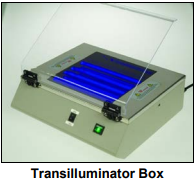Ultraviolet Radiation Safety Fact Sheet
Ultraviolet light (UV) is non-ionizing radiation with wavelengths ranging from 180 to 400 nanometers, from the blue end of the visible spectrum to the X-ray region of the electromagnetic spectrum. The ultraviolet spectrum is commonly divided into the following three regions:
| Region | Region Name | Wavelength (nm) | Hazard Rating |
|---|---|---|---|
| UVA | Black Light | 315-400 | Lowest |
| UVB | Eurythermal | 280-314 | Mid to high |
| UVC | Germicidal | 180-280 | Highest |
Exposure to ultraviolet radiation is typically limited to the UVA region resulting from exposure to direct sunlight. The Earth's atmosphere shields us from the more harmful UVC and greater than 99% of UVB radiation. Some equipment used in laboratories can generate concentrated UV radiation in all the spectral regions. These sources can cause injury with only a few seconds of exposure if used without appropriate shielding and personal protective equipment.
Common Sources of UV Radiation in Laboratories
There are several sources of UV radiation in the laboratory including germicidal lamps in biological safety cabinets, nucleic acid transillumination boxes, nucleic acid crosslinkers and UV lasers. Laser safety information is viewable.
Hazards Associates with Exposure to UV Light
An unfortunate property of UV radiation is that there are no immediate warning symptoms to indicate overexposure. Symptoms of overexposure including varying degrees of erythema (sunburn) or photokeratitis (welder's flash) typically appear hours after exposure has occurred.
-
 Skin Injury UV radiation can initiate a photochemical reaction called erythema within exposed skin. This "sunburn" can be quite severe and can occur as a result of only a few seconds exposure. Effects are exaggerated for skin photosensitized by agents such as coal tar products, certain foods (e.g., celery root), certain medications and photoallergens. Chronic skin exposure to UV radiation has been linked to premature skin aging, wrinkles and skin cancer.
Skin Injury UV radiation can initiate a photochemical reaction called erythema within exposed skin. This "sunburn" can be quite severe and can occur as a result of only a few seconds exposure. Effects are exaggerated for skin photosensitized by agents such as coal tar products, certain foods (e.g., celery root), certain medications and photoallergens. Chronic skin exposure to UV radiation has been linked to premature skin aging, wrinkles and skin cancer. -
 Eye Injury UV radiation exposure can injure the cornea, the outer protective coating of the eye. Photokeratitis is a painful inflammation of the eye caused by UV radiation-induced lesions on the cornea. Symptoms include a sensation of sand in the eye that may last up to two days. Chronic exposures to acute high-energy UV radiation can lead to the formation of cataracts.
Eye Injury UV radiation exposure can injure the cornea, the outer protective coating of the eye. Photokeratitis is a painful inflammation of the eye caused by UV radiation-induced lesions on the cornea. Symptoms include a sensation of sand in the eye that may last up to two days. Chronic exposures to acute high-energy UV radiation can lead to the formation of cataracts.
Engineering Controls and Safe Work Practices
As with other sources of radiation, UV presents an external hazard that can be controlled with a combination of time (minimize exposure duration) distance (maximize distance from the source) and shielding (utilize effective shielding materials). Never allow skin or eyes to be exposed to UV radiation Transilluminator Box UV Crosslinker sources. The UV radiation generated by laboratory equipment can exceed recommended exposure limits and cause injury with exposures as brief as three seconds in duration.
- Biological Safety Cabinets Germicidal UV lamps are not required in BSCs and should only be used as a secondary means of decontamination. Never work in a biological safety cabinet while the UV lamp is on and close the sash when the UV lamp is in use.
- Transilluminators Do not use a transilluminator without the protective shield in place! Shields must be kept clean and replaced when damaged.
- Crosslinkers Crosslinkers must not be used if the door safety interlock is not working properly.
Equipment Labeling
Many overexposures to UV radiation have occurred as a result of individuals not knowing the hazards associated with UV-emitting equipment. To help prevent eye and skin injuries, any equipment that emits UV radiation must be conspicuously labeled with a caution label. The label language should contain:
CAUTION
UV RADIATION HAZARD
USE ONLY WITH SHIELDING IN PLACE
PROTECT EYES AND SKIN FROM EXPOSURE TO UV LIGHT
Check with the equipment manufacturer for proper labels, or contact OEHS&S for assistance.
Personal Protective Equipment (PPE)
- Protective Clothing: Wear standard laboratory apparel including a fully buttoned lab coat, long pants and closed toe shoes. While working with UV radiation sources, lab workers must be particularly vigilant to prevent gaps in protective clothing that commonly occur around the neck and wrist areas.
- Eye/Face Protection: If there is any potential for the eyes and face to be exposed to UV radiation, a polycarbonate face shield stamped with the ANSI Z87.1-1989 UV certification must be worn to protect the eyes and face. Ordinary prescription eyeglasses may not block UV radiation. UV certified goggles and safety glasses will protect the eyes, but it is common for lab workers to suffer facial burns in the areas not covered by the goggles or glasses.
- Gloves: Wear disposable nitrile gloves to protect exposed skin on the hands. Ensure wrists and forearms are covered between the tops of gloves and the bottom of the lab coat sleeves.
Emergency Procedures
UV related exposures/injuries should be immediately reported to your supervisor. Seek medical attention at a WSU authorized healthcare provider, as outlined in the Emergency Procedures posting.